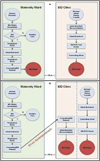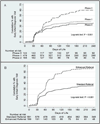Addressing poor retention of infants exposed to HIV: a quality improvement study in rural Mozambique
- PMID: 22622077
- PMCID: PMC3587032
- DOI: 10.1097/QAI.0b013e31824c0267
Addressing poor retention of infants exposed to HIV: a quality improvement study in rural Mozambique
Erratum in
- J Acquir Immune Defic Syndr. 2012 Jul 1;60(3):e106
Abstract
Objective: Early infant diagnosis (EID) is the first step in HIV care, yet 75% of HIV-exposed infants born at 2 hospitals in Mozambique failed to access EID.
Design: Before/after study.
Setting: Two district hospitals in rural Mozambique.
Participants: HIV-infected mother/HIV-exposed infant pairs (n = 791).
Intervention: We planned 2 phases of improvement using quality improvement methods. In phase 1, we enhanced referral by offering direct accompaniment of new mothers to the EID suite, increasing privacy, and opening a medical record for infants before postpartum discharge. In phase 2, we added enhanced referral activity as an item on the maternity register to standardize the process of referral.
Main outcome measure: The proportion of HIV-infected mothers who accessed EID for their infant <90 days of life.
Results: We tracked mother/infant pairs from June 2009 to March 2011 (phase 0: n = 144; phase 1: n = 479; phase 2: n = 168), compared study measures for mother/infant pairs across intervention phases with χ², estimated time-to-EID by Kaplan-Meier, and determined the likelihood of EID by Cox regression after adjusting for likely barriers to follow-up. At baseline (phase 0), 25.7% of infants accessed EID <90 days. EID improved to 32.2% after phase 1, but only 17.3% had received enhanced referral. After phase 2, 61.9% received enhanced referral and 39.9% accessed EID, a significant 3-phase improvement (P = 0.007). In adjusted analysis, the likelihood of EID at any time was higher in the phase 2 group versus phase 0 (adjusted hazard ratio: 1.68, 95% confidence interval: 1.19 to 2.37, P = 0.003).
Conclusions: Retention improved by 55% with a simple referral enhancement. Quality improvement efforts could help improve care in Mozambique and other low-resource countries [added].
Figures


Similar articles
-
Attrition of HIV-exposed infants from early infant diagnosis services in low- and middle-income countries: a systematic review and meta-analysis.J Int AIDS Soc. 2018 Nov;21(11):e25209. doi: 10.1002/jia2.25209. J Int AIDS Soc. 2018. PMID: 30649834 Free PMC article.
-
Use of peers, community lay persons and Village Health Team (VHT) members improves six-week postnatal clinic (PNC) follow-up and Early Infant HIV Diagnosis (EID) in urban and rural health units in Uganda: A one-year implementation study.BMC Health Serv Res. 2015 Dec 15;15:555. doi: 10.1186/s12913-015-1213-5. BMC Health Serv Res. 2015. PMID: 26666331 Free PMC article.
-
Predictors of successful early infant diagnosis of HIV in a rural district hospital in Zambézia, Mozambique.J Acquir Immune Defic Syndr. 2011 Apr;56(4):e104-9. doi: 10.1097/QAI.0b013e318207a535. J Acquir Immune Defic Syndr. 2011. PMID: 21266912 Free PMC article.
-
The Impact of Structured Mentor Mother Programs on Presentation for Early Infant Diagnosis Testing in Rural North-Central Nigeria: A Prospective Paired Cohort Study.J Acquir Immune Defic Syndr. 2017 Jun 1;75 Suppl 2:S182-S189. doi: 10.1097/QAI.0000000000001345. J Acquir Immune Defic Syndr. 2017. PMID: 28498188
-
Improved access to early infant diagnosis is a critical part of a child-centric prevention of mother-to-child transmission agenda.AIDS. 2013 Nov;27 Suppl 2:S197-205. doi: 10.1097/QAD.0000000000000104. AIDS. 2013. PMID: 24361629 Review.
Cited by
-
Correlates of loss to follow-up and missed diagnosis among HIV-exposed infants throughout the breastfeeding period in southern Mozambique.PLoS One. 2020 Aug 21;15(8):e0237993. doi: 10.1371/journal.pone.0237993. eCollection 2020. PLoS One. 2020. PMID: 32822388 Free PMC article.
-
Attrition of HIV-exposed infants from early infant diagnosis services in low- and middle-income countries: a systematic review and meta-analysis.J Int AIDS Soc. 2018 Nov;21(11):e25209. doi: 10.1002/jia2.25209. J Int AIDS Soc. 2018. PMID: 30649834 Free PMC article.
-
Patterns of mobility and its impact on retention in care among people living with HIV in the Manhiça District, Mozambique.PLoS One. 2021 May 21;16(5):e0250844. doi: 10.1371/journal.pone.0250844. eCollection 2021. PLoS One. 2021. PMID: 34019556 Free PMC article.
-
Translation of biomedical prevention strategies for HIV: prospects and pitfalls.J Acquir Immune Defic Syndr. 2013 Jun 1;63 Suppl 1(0 1):S12-25. doi: 10.1097/QAI.0b013e31829202a2. J Acquir Immune Defic Syndr. 2013. PMID: 23673881 Free PMC article. Review.
-
Correlates of suboptimal entry into early infant diagnosis in rural north central Nigeria.J Acquir Immune Defic Syndr. 2014 Sep 1;67(1):e19-26. doi: 10.1097/QAI.0000000000000215. J Acquir Immune Defic Syndr. 2014. PMID: 24853310 Free PMC article.
References
-
- UNAIDS. Global Report: UNAIDS report on the global AIDS epidemic 2010. 2010 Available at: http://www.unaids.org/globalreport/Global_report.htm.
-
- Stringer EM, Ekouevi DK, Coetzee D, et al. Coverage of nevirapine-based services to prevent mother-to-child HIV transmission in 4 African countries. JAMA. 2010;304:293–302. - PubMed
-
- Perez F, Mukotekwa T, Miller A, et al. Implementing a rural programme of prevention of mother-to-child transmission of HIV in Zimbabwe: first 18 months of experience. Trop Med Int Health. 2004;9:774–783. - PubMed
-
- Manzi M, Zachariah R, Teck R, et al. High acceptability of voluntary counselling and HIV-testing but unacceptable loss to follow up in a prevention of mother-to-child HIV transmission programme in rural Malawi: scaling-up requires a different way of acting. Trop Med Int Health. 2005;10:1242–1250. - PubMed
Publication types
MeSH terms
Grants and funding
LinkOut - more resources
Full Text Sources
Medical

